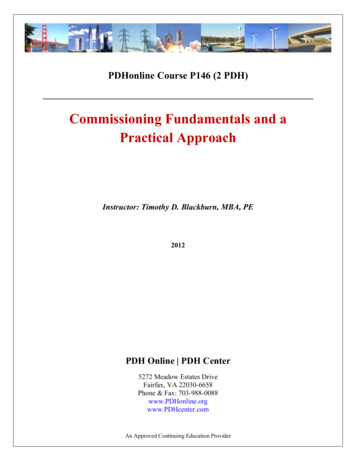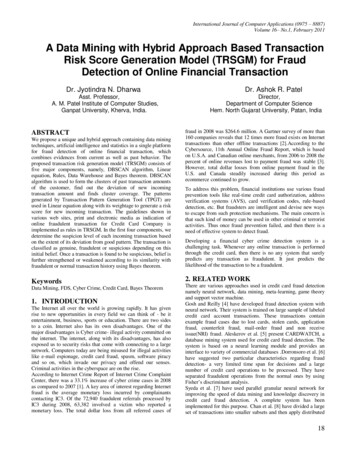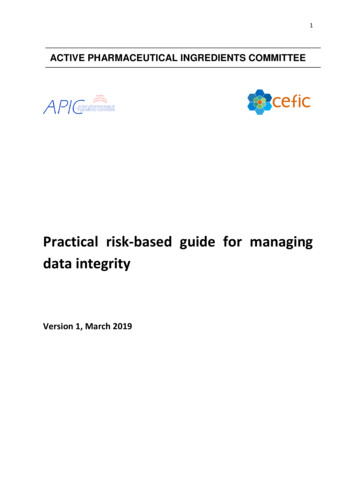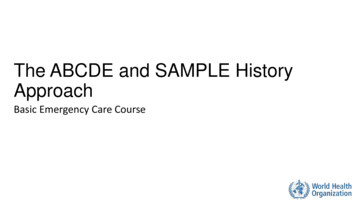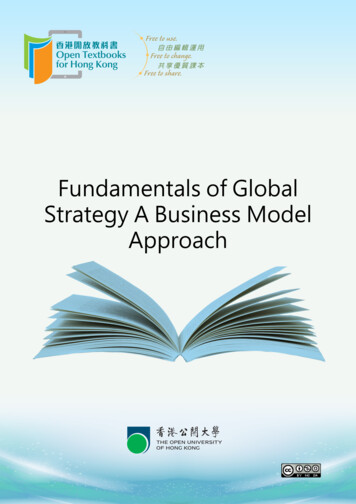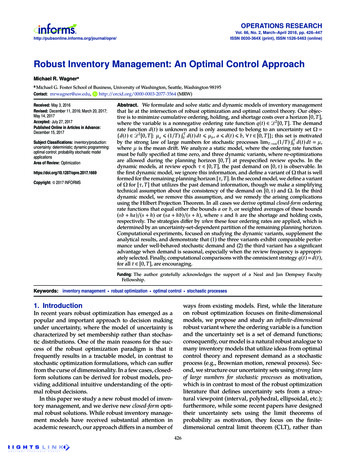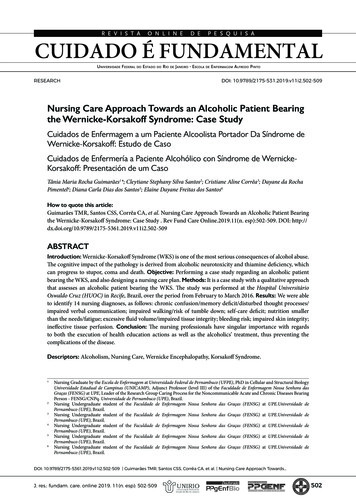
Transcription
A Practical Approach to Risk Assessmentand Risk ReductionPresented byRichard Harris Omron STI 2012
Today’s Learning Objectives What is a risk assessment and why do I have to do it?Who can do a risk assessment?How do I do it?What is the difference between risk assessment and riskreduction? What tools are available? Omron STI 2012
What is it? Risk Assessment The process by which the intended use (and reasonablyforeseeable misuse) of the machine, the tasks and hazards, andthe level of risk are determined Risk Reduction The application of protective measures to reduce the risk to atolerable level Omron STI 2012
Why do it? To create a safer working environment for employees (as required by OSHA)To reduce costsTo comply with national and international consensus standards, including:ANSI B11.0-2010 – Safety of Machinery – General Requirements and Risk AssessmentANSI B11.TR3-2000 – Risk Assessment and Risk Reduction – A Guide to Estimate, Evaluate and Reduce Risks Associated withMachine ToolsANSI/RIA R15.06-1999 (R2009) – For Industrial Robots and Robot Systems – Safety RequirementsNFPA 79-2012 – Electrical Standard for Industrial MachineryANSI/ASSE Z244.1-2003 (R2008) – Control of Hazardous Energy – Lockout/Tagout and Alternative MethodsANSI/PMMI B155.1-2011 – Standard for Packaging Machinery and Packaging-Related Converting Machinery – Safety Requirementsfor Construction, Care, and UseSEMI S10-0307 – Safety Guideline for Risk Assessment and Risk Evaluation ProcessMIL-STD-882D-2000 – Standard Practice for System SafetyCSA Z432-04 – Safeguarding of Machinery – Occupational Health and SafetyCSA Z434-03 – Industrial Robots and Robot Systems – General Safety RequirementsCSA Z460-05 – Control of Hazardous Energy – Lockout and Other MethodsNOM-004-STPS-1999 – Protection Systems and Safety Devices for Machinery and Equipment Used in the WorkplaceISO 12100:2010 – Safety of machinery – General principles for design – Risk assessment and risk reductionEN 954-1:2000 / ISO 13849-1:1999 – Safety of machinery – Safety-related parts of control systems – Part 1: General principles ofdesignISO 13849-1:2006 – Safety of machinery – Safety-related parts of control systems – Part 1: General principles of design2006/42/EC – European Machinery Directive Omron STI 2012
How do I do it? Regardless of which standard you follow, the processcontains 12 essential steps You can create your own process, as long as it’sbased on industry best practices You can conduct the process in house, request it fromyour OEM, or contract an outside service provider Omron STI 2012
Identify Machine / Process Usually done in reaction to an accident / near miss thathas already occurred Think Proactive! Can be prioritized based on common sense (morehazardous machines first) Based on hazards and/or frequency of use Omron STI 2012Step 1
Collect Proper Information Limits of the machine Requirements for the lifecycle of the machine Design drawings, sketches, system descriptions, or other meansof establishing the nature of the machine Information concerning energy sources Any accident and incident history Any information about damage to health System layout and proposed building / existing system(s)integration Affected personnel Level of training, experience, or ability of all personnel Exposure of other persons to the hazards associated with themachine where it can be reasonably foreseen Omron STI 2012Step 2
Gather Proper PersonnelEHS managerOperatorsMaintenance personnelEngineersElectriciansProduction managersSpecialistsUse Omron STI 2012approachStep 3
Observe Machine in UseAlthough many machines aresimilar in design, they areadapted to perform specific ordifferent operationsThe best way to understandthe operation and maintenanceof a machine is to see it in use– This helps ensure safety andcompliance while understandingand meeting productivity needs Omron STI 2012Step 4
Identify Hazardous Areas Follow task/hazard approach Tasks include:Packing and transportingUnloading/unpackingSystems installationStart up/commissioningSet up and try outOperation (all modes)Tool changeMajor repairPlanned maintenanceUnplanned maintenanceRecovery from posal Omron STI 2012Step 5
Task / Hazard ice PersonnelQuality CoachSales PersonnelContractorsRiggers Omron STI 2012Hazard
Task / Hazard ApproachPersonnelTaskOperatorLoadOperatorUnload PartOperatorUnload ScrapOperatorCycleOperatorLube DieOperatorClean DieOperatorTape DieOperatorPower UpOperatorPower DownOperatorClean PressOperatorClean WorkspaceOperatorTeach TraineesMaintenanceChange DieMaintenanceFirst Piece VerificationMaintenancePreventative MaintenanceMaintenanceRecovery from Crash Omron STI 2012Hazard
Task / Hazard ratorLoadCutting or SeveringOperatorLoadStabbing or PuncturingOperatorLoadContact with Live PartsOperatorLoadReaction to Stainless SteelOperatorLoadFailure of the Control SystemOperatorLoadFailure of the EquipmentOperatorLoadSlip, Trip, or FallOperatorLoadFalling ObjectsOperatorLoadEjected Objects or FluidsOperatorUnload PartCrushingOperatorUnload PartShearingOperatorUnload PartCutting or SeveringOperatorUnload PartContact with Live PartsOperatorUnload PartReaction to Stainless SteelOperatorUnload PartFailure of the Control System Omron STI 2012
Identifying Tasks & Hazards ANSI B11.0-2010Identifying tasks and hazards is a critically important part of the risk assessmentprocess because hazards not identified can create substantial unknown risks. Thereare many different approaches to identifying hazards. Depending on the complexity ofthe machinery, useful methods may include but are not limited to:using intuitive operational and engineering judgment;examining system specifications and expectations;reviewing codes, regulations, and consensus standards;interviewing current or intended system users and/or operators;consulting checklists;reviewing studies from other similar systems;evaluating the potential for unwanted energy releases/exposures to hazardous environments;reviewing historical data/industry experience, incident investigation reports (including accident or near-missevents), OSHA, Bureau of Labor Statistics and National Safety Council data, manufacturer’s literature; considering potential mishaps with surrounding equipment and operations; brainstorming. Omron STI 2012
Assumptions The risk assessment process includes identifying hazardsregardless of the existence of risk reduction (safeguarding)measures. The machine should not be considered harmless as shipped andguarded. To assure that all hazards are included, hazard identificationshould be conducted with all safeguards conceptually removed. This is to assure that hazards are not ignored due to an assumption that the safeguardsupplied is adequate for all tasks, including reasonably foreseeable misuse. Existing safeguards that help meet the risk reduction objectivescan be retained after evaluating their performance. This decision will be confirmed during the validation/verification portion of the riskassessment. Omron STI 2012
Identify the Risk Level and Required Level of RiskReduction There are several recognized methods to identify (label)risk levels ANSI, RIA, CSA, EN, ISO Choose the method which is easiest and most practical toapply at your location Risks must be aligned to a risk reduction category thatincorporates the selection of safeguarding devices andsafety-related parts of the control system Omron STI 2012Steps 6 & 7
ANSI B11.TR3 7.2 Severity of harmSeverity of harm addresses the degree of injury or illness that could occur. Thedegrees are based on extent of injury or illness (from death to no injury), andextent of treatment involved. The following is an example of severity levels: Catastrophic – death or permanently disabling injury or illness (unable to return to work)Serious – severe debilitating injury or illness (able to return to work at some point)Moderate – significant injury or illness requiring more than first aid (able to return to same job)Minor – no injury or slight injury requiring no more than first aid (little or no lost work time)When determining risk, the worst credible severity of harm is to be selected. 7.3 Probability of occurrence of harmProbability of occurrence of harm is estimated by taking into account thefrequency, duration and extent of exposure, training and awareness, and thepresentation of the hazard. The following is an example of probability levels: Very likely – near certain to occurLikely – may occurUnlikely – not likely to occurRemote – so unlikely as to be near zeroWhen estimating probability, the highest credible level of probability is to be selected. Omron STI 2012
ANSI B11.TR3Severity ry leNegligibleTable 1: Risk Determination Matrix Omron STI 2012
ANSI B11.TR3 Safeguards providing the highest degree of risk reduction are: Safeguards providing high / intermediate risk reduction are: Barrier guard or protective device preventing unintended exposure of any part of the body to the hazard, and notremovable or adjustable by unauthorized persons. If moveable, such a barrier should be interlocked using system controlcriteria as defined in this paragraph.Physical devices that do not require adjustment for use or other operator intervention.– Control systems having redundancy with self-checking upon startup to ensure the continuance of performance.Safeguards providing low / intermediate risk reduction are: Barrier guard or protective device preventing intentional exposure of any part of the body to the hazard, and securedwith special fasteners or a lock. If moveable, such a barrier should be interlocked using system control criteria as defined inthis paragraph.Control systems having redundancy with continuous self-checking to ensure the continuance of performance.Barrier guard or protective device providing simple guarding against inadvertent exposure to the hazard. Examples area fixed screen, chuck guard, or moveable barrier with simple interlocking using system control criteria as defined in thisparagraph.Physical devices that require adjustment for use.Control systems (including associated protective devices, actuators and interfaces) having redundancy that may bemanually checked to ensure the continuance of performance.Safeguards providing the lowest degree of risk reduction are: Physical barrier providing tactile or visual awareness of the hazard, or minimal protection against inadvertent exposure.Examples are post and rope, swing-away shield, or moveable screen.Electrical, electronic, hydraulic or pneumatic devices and associated control systems using a single-channel configuration. Omron STI 2012
ANSI/RIA R15.06Table rmally Irreversible; or fatality; or requires more than first-aid asS2 Serious Injurydefined in OSHA 1904.12Normally reversible; or requires only first-aid as defined in OSHAS1 Slight Injury1904.12FrequentTypically exposure to the hazard more than once per hour.E2ExposureInfrequentTypically exposure to the hazard less than once per day or shift.E1ExposureCannot move out of the way; or inadequate reaction time; orNot LikelyA2robot speed greater than 250mm/sec.Can move out of the way; or sufficient warning/reaction time; orA1Likelyrobot speed less than 250mm/sec.Table 1 - Hazard Severity/Exposure/Avoidance Categories Omron STI 2012
ANSI/RIA R15.06Table 2Avoidance Risk Reduction CategoryExposureE2 FrequentA2 Not LikelyR1S2 Serious InjuryA1 LikelyExposureR2AMore thanE1 InfrequentA2 Not LikelyR2BFirst-aidA1 LikelyExposureR2BE2 FrequentA2 Not LikelyR2CA1 LikelyExposureS1 Slight InjuryR3AFirst-aidA2 Not LikelyR3BE1 InfrequentA1 LikelyExposureR4Table 2 - Risk reduction decision matrix prior to safeguard selectionSeverity of Exposure Omron STI 2012
ANSI/RIA R15.06Table 3CategoryR1R2AR2BR2CR3ASafeGuard PerformanceCircuit PerformanceHazard Elimination or hazard substitutionControl Reliable (4.5.4)(9.5.1)Engineering controls preventing acess to Control Reliable (4.5.4)the hazard, or stopping the hazard (9.5.2),e.g. interlocked barrier guards, lightSingle Channel with monitoring (4.5.3)curtains, safety mats, or other presencesensing devices (10.4)Single Channel (4.5.2)Non interlocked barriers, clearance,procedures and equipment (9.5.3)R3BR4Awareness means (9.5.4)Single Channel (4.5.2)Simple (4.5.1)Simple (4.5.1)Table 3 - Safeguard Selection Matrix Omron STI 2012
Risk Reduction MeasuresModified Table 3Circuit feguard PerformanceHazard Elimination or hazardsubstitutionEngineering controls preventingacess to the hazard, or stoppingthe hazard, e.g. interlocked barrierguards, light curtains, safetymats, or other presence sensingdevicesANSI/RIAR15.06-1999(R2009)ISO 10218-2ISO 10218-1ISO 13849-1:1999 ISO 13849-1:2006 IEC 62061:2005CategoryPLSILControl Reliable(4) 3(e) d(3) 2Control Reliable3d2Single Channelwith Monitoring2d/c2/1Single Channel1c1b1b1an/aNon interlocked barriers,Single Channel1clearance, procedures andSimplebequipmentAwareness meansSimplebTable 3 - Safeguard Selection Matrix Omron STI 2012
ANSI/RIA R15.06 R1 Risk reduction shall be accomplished by hazard elimination or hazardsubstitution which does not create an equal or greater hazard. Whenhazard elimination or substitution is not possible, all provisions of acategory R2 risk reduction shall apply and provisions of categories R3and R4 shall be provided for safeguarding residual risk. R2 Safeguarding shall be by means that prevent access to th
CSA Z432-04 –Safeguarding of Machinery –Occupational Health and Safety CSA Z434-03 –Industrial Robots and Robot Systems –General Safety Requirements CSA Z460-05 –Control of Hazardous Energy –Lockout and Other Methods NOM-004-STPS-1999 –Protection Systems and Safety Devices for Machinery and Equipment Used in the Workplace ISO 12100:2010 –Safety of machinery –General .
